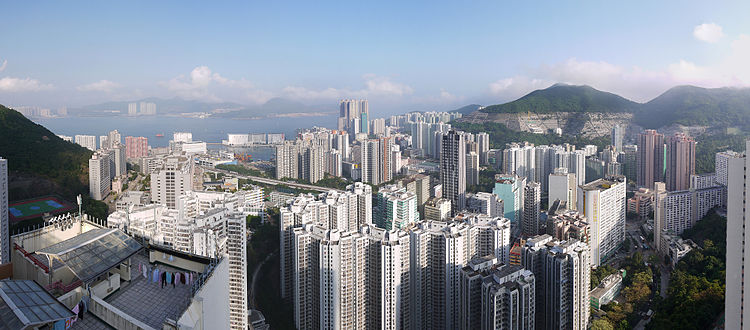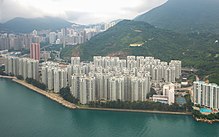

22°16′N 114°14′E / 22.27°N 114.24°E / 22.27; 114.24
| Chai Wan | |||||||||||
|---|---|---|---|---|---|---|---|---|---|---|---|

| |||||||||||
| Traditional Chinese | 柴灣 | ||||||||||
| Simplified Chinese | 柴湾 | ||||||||||
| Hanyu Pinyin | Cháiwān | ||||||||||
| Literal meaning | firewood bay | ||||||||||
| |||||||||||
Chai Wan (/ˌtʃaɪ ˈwɑːn/; Chinese: 柴灣), formerly known as Sai Wan (西灣), [citation needed] lies at the east end of the urban area of Hong Kong Island next to Shau Kei Wan. The area is administratively part of the Eastern District, and is a mosaic of industrial and residential areas. The population was 186,505 in 2001.

Chai Wan is built on land reclaimed from the bay and extends west from Lei Yue Mun in Heng Fa Chuen (see below) and east to Siu Sai Wan. Mount Collinson and Pottinger Peak on the south and Mount Parker on the west, restrict further development. Shek O Country Park is at the south of Chai Wan.

The name "Chai" literally means firewood, while "Wan" means bay. Its naming possibly because of rich production of firewood in early days.
The book Lo Uk folk Museum stated it was possible there were inhabitants settled in Chai Wan during Northern Song and Southern Song Dynasty. During that period, there were merchants bought water in Chai Wan before they continued their journey to Guangzhou, Fujian province, for instance


Chai Wan was formerly known as Sai Wan (西灣), meaning "West Bay". At the beginning of the 18th century, the area consisted of six villages: Dai Ping Village, Law Uk, Luk Uk, Nam Uk, Sai Village, Sing Uk.
In 1845, the British military built a fort and a barracks in Siu Sai Wan. In December 1941, the Japanese invasion of the island resulted in the Battle of Hong Kong, with approximately 20 gunners executed at the Sai Wan Battery despite having surrendered. After the fort was closed in the 1980s, Sai Sau Wan become an area for new population.
In 1929, the Boy Scouts Association, Hong Kong Branch purchased land for the Chai Wan Campsite where Chai Wan Park is now situated. The land returned to Hong Kong Government for development in the early 1970s.
In 1952, the government began building low-income housing that gradually replaced rural villages in the area.
MTR Island line[1] and Eastern Corridor Phrase 3[2] opened in 1985 and 1989 respectively, improving connection with rest of the Island and Hong Kong.
The Law Uk Folk Museum was formerly a village and is now a museum, a branch of the Hong Kong Museum of History.
This area has about 200-300 high rise buildings, most of them residential. It also has a number of public housing estates.
| Heng Fa Chuen | |||||||||||||
|---|---|---|---|---|---|---|---|---|---|---|---|---|---|

A bird's eye view of Heng Fa Chuen
| |||||||||||||
| Traditional Chinese | 杏花邨 | ||||||||||||
| Simplified Chinese | 杏花邨 | ||||||||||||
| Jyutping | Hang6 Faa1 Cyun1 | ||||||||||||
| Literal meaning | Almond Flower Village | ||||||||||||
| |||||||||||||
Heng Fa Chuen is a private residential estate in Chai Wan, jointly developed by MTR Corporation and Kerry Properties. Construction of the residential estate began on 13 August 1977, ended on 26 April 1982 and officially opened on 10 July 1982.
The area was reclaimed from Pak Sha Wan (白沙灣) and Lei Yue Mun Bay (鯉魚門灣). The current promenade along the shoreline was once a beach, surrounded by barren hills and vegetation. Further west, there was once a quarry, near to the site of the Hong Kong Museum of Coastal Defence. However, the quarry was decommissioned by the Hong Kong Government, after it was mined out. The miners dispersed, with some moving to Chai Wan and settling in wooden houses. There were still traces of it when the Hong Kong Museum of Coastal Defence was established.
In the early 1980s, when the Island line of the MTR was being planned, the working name of the station was "Chai Wan Quay", according to the Freeman, Fox, Wilbur Smith & Associates Mass Transportation Study. It became Heng Fa Chuen when MTR became the rightful developer of the land for the station and depot. Not only was the name changed, but also it was relocated to its present place from the old location near Chai Wan pier/Ming Pao Industrial Centre.
There are 6,504 apartments in 48 residential blocks[3] managed by MTR Property Management, with Paradise Mall, a shopping centre,[4] attached to it. The world's 11,000th McDonald's fast-food restaurant was opened at Heng Fa Chuen in 1989.[5] In 2000, a PARKnSHOP supermarket replaced the existing Carrefour giant chain supermarket. This Carrefour store, which opened in December 1996, was the first one opened in Hong Kong. It is an item of note that the area used to be under the flightpath of planes landing on the southern side of Kai Tak Airport's runway, and therefore most tower blocks had to be built lower than 20 floors.[6][7]
Siu Sai Wan is a newly developed residential area, located in the eastern part of Chai Wan. Notable landmarks in Siu Sai Wan include the largest sports ground on Hong Kong Island, the Siu Sai Wan Sports Ground[8] and one of the largest private housing estates on Hong Kong Island, Island Resort.[9] The population is about 80,000.
The head office of Media Chinese is in the Ming Pao Industrial Centre (traditional Chinese: 明報工業中心; simplified Chinese: 明报工业中心) in Chai Wan.[10]


Schools in the area include:
In Heng Fa Chuen:
Chai Wan is in Primary One Admission (POA) School Net 16. Within the school net are multiple aided schools (operated independently but funded with government money) and two government schools: Shau Kei Wan Government Primary School and Aldrich Bay Government Primary School.[13]
Mount Collinson has a range of cemeteries:

Chai Wan is served by two stations of the MTR rapid transit railway, both on the Island line:
The Chai Wan Depot is located under blocks 1 to 18 of Heng Fa Chuen Estate and beside Heng Fa Chuen station. It houses trains serving on the Island line, and inspections of trains are carried out here.
Hong Kong Address: 15/F, Block A, Ming Pao Industrial Centre, 18 Ka Yip Street, Chai Wan, Hong Kong- Traditional Chinese: "香港柴灣嘉業街18號明報工業中心A座15樓" - Simplified Chinese: "香港柴湾嘉业街18号明报工业中心A座15楼"
Places adjacent to Chai Wan
| |
|---|---|